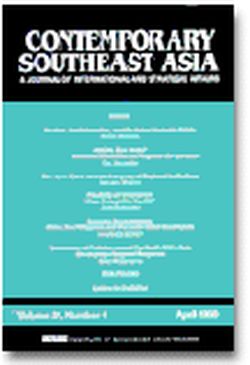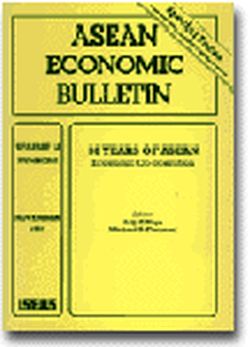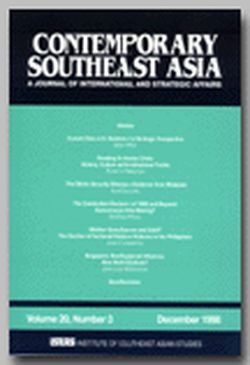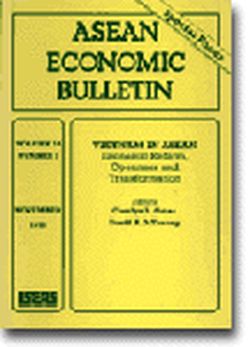Contemporary Southeast Asia: A Journal of International and Strategic Affairs Vol. 21/2 (Aug 1999)
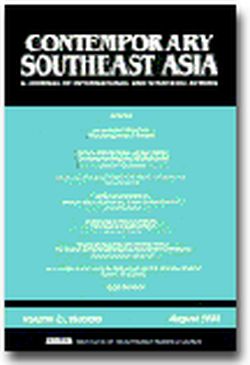
Date of publication:
August 1999
Number of pages:
172
Code:
CS21/2
Contents
-
Preliminary Pages
-
Hegemonic America: The Arrogance of Power, by Bob Catley, contributor see abstractThree times in the twentieth century the United States attempted to use its power to impose a liberal world order: in 1919, 1945-48, and after the Cold War. We now call it globalization. During the 1990s, the United States has been the miracle economy and its corporations have assumed ascendancy. Since 1996, after President Bill ClintonâÂÂs re-election, the United States has been increasingly assertive; it has used its power to prop up the Russian President, bully the Chinese into liberalization, push the stagnant Japanese economy towards reform, insist on the âÂÂWashington consensusâ of liberalization, and try to control the United Nations. In the 1997-98 Asian economic meltdown, the United States used the International Monetary Fund to push for political reform in East Asia. Washington is now using NATO to redefine the meaning of sovereignty in the Balkans. The United States has shifted from being a benign hegemon to an arrogant superpower and this will likely generate a hostile reaction.
-
China's ASEAN Policy in the 1990s: Pushing for Regional Multipolarity see abstractOver the past two decades, Chinese leaders have valued good relations with the ASEAN states. ASEAN is even considered as one of the poles in the multipolar power transfiguration in the Asia-Pacific region. Both China and ASEAN intend to play a more significant role in the Asia-Pacific and beyond. Their pursuits are a non-zero sum game and can be mutually supportive. The Asia-Pacific region needs effective representatives in negotiations with the Western powers and in various international organizations. China and ASEAN, on the basis of close bilateral and regional consultations, can perform that role together. But meanwhile, Chinese leaders still face the arduous task of reducing, if not eliminating altogether, fears of a âChina threatâ and inducing acceptance of their ânew international political and economic orderâ among the ASEAN states.
-
Challenges Facing ASEAN in a More Complex Age, by John Funston, contributor see abstractRecent high-profile conflicts between ASEAN members have given the impression of an organization in disarray. These followed ASEANâs earlier perceived failure to respond effectively to the regional economic crisis and the haze from Indonesian forest fires. ASEANâs 1997 admission of Myanmar, and postponement of Cambodiaâs entry following a military coup, also elicited much controversy. While many criticisms of ASEAN reflect little understanding of the organizationâs nature or origins, ASEANâs world has become a lot more complex in the past two years. The economic crisis and ASEAN expansion are partly responsible. But ASEAN has also faced additional challenges from the changing nature of international finance, different practices of international relations since the end of the Cold War, and the growth of civil society in member countries. ASEAN is addressing these issues, but it needs to do more.
-
APEC and the WTO: Which Way Forward for Trade Liberalization?, by John Funston, author see abstractThe relative effectiveness of APEC and the WTO in promoting trade liberalization was brought into sharp relief when APEC decided to refer its programme of âÂÂEarly Voluntary Sectoral Liberalizationâ to the WTO. The WTOâÂÂs success in liberalizing trade in large part stems from clearly specified obligations, legally-binding commitments, reciprocity, and non-discrimination. These characteristics have helped the WTO to discourage opportunistic behaviour by its members; moreover, they have helped governments to resolve domestic political economy problems associated with trade liberalization. In contrast, APECâÂÂs reliance on voluntary compliance with unilaterally defined commitments provides little certainty about the behaviour of partner economies, and fails to address domestic political economy problems. APEC is increasingly likely to return to its roots â the OECD model of trade facilitation and economic and technical facilitation.
-
Indonesia's Role in ASEAN: The End of Leadership?, by Anthony L Smith, contributor see abstractEconomic and political crisis in Indonesia has had a marked impact on Indonesiaâs ability to participate fully in international affairs, including its relations with Southeast Asia and its participation within ASEAN. In the past, Indonesia has been described as the leader of ASEAN, and it can be shown that Indonesia has had a marked impact on the formation of, and developments within, ASEAN. The economic crisis, questions over Indonesiaâs political stability, forest fires, bilateral disputes between ASEANâs member states and so on have all taken their toll on ASEANâs cohesion. While ASEAN remains an important regional body, clearly Indonesiaâs leadership of the grouping has been tested and found wanting.
-
National Security and Malay Unity: The Issue of Radical Religious Elements in Malaysia see abstractIslam in Malaysia has become an identifying theme of Malay unity in the country and has constituted a powerful weapon in the struggle for political supremacy. It has been used as a continuing source of political legitimacy and as a shield both internally vis-Ã -vis other communities and against external influences in Malay politics. Paradoxically, it is this very use which now threatens to make Islam a dividing factor, both for inter-communal and Malay unity. Indeed, although the presence of Islam in Malay society and politics is not new, the manner in which it has been employed since the 1980s is of serious concern to the Malaysian Government and the various ethnic and religious communities in the country. This article provides an analysis of this complex issue.
-
Burma/Myanmar and the Dilemmas of U.S. Foreign Policy see abstractThe political situation in Burma/Myanmar is in stasis between the military State Peace and Development Council and the National League for Democracy. Both have established mutually antithetical conditions for dialogue. At the same time, military power has increased, a new constitution is being interminably written under military authority, the military is intent on the destruction of the oppositionâs political infrastructure, the economy has deteriorated and living conditions throughout the country have declined. The U.S. policy demanding that the military honour the results of the May 1990 elections, overwhelmingly won by the opposition, and the imposition of sanctions on new U.S. investments have not been successful in either prompting dialogue or dismantling military rule. The article suggests modification of the policy, outlines the core beliefs and constraints among all parties, and outlines measured steps that might improve both political and economic conditions.
- BOOK REVIEWS
-
BOOK REVIEW: Thailand and the Southeast Asian Networks of the Vietnamese Revolution, 1885-1954. By Christopher E. Goscha, by Zachary Abuza, contributor
-
BOOK REVIEW: China’s Provinces in Reform: Class, Community, and Political Culture. Edited by David S. G. Goodman, by Andrew M Marton, contributor
-
BOOK REVIEW: Dynamics in Pacific Asia: Conflict, Competition and Cooperation. Edited by Kurt W. Radtke et al.

